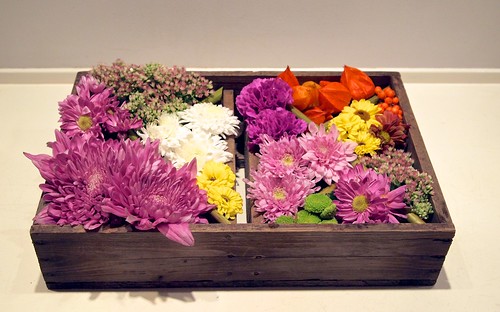One of my former ikebana students told me that although he really liked the ikebana classes, there was one thing that had been a disappointment to him. Knowing that ikebana is a deeply spiritual art form, he had expected that watching the flowers wither, going through all the stages of life, would also be part of the ikebana concept. Why are the flowers removed when they don't look fresh anymore? I've gotten this question from several other people too. Maybe it's a Scandinavian thing having to do with living close to nature and being part of a culture that appreciates an honest and sometimes rough approach to the facts of life.
Leftover flowers: Sticks of Japanese Knotweed, Chrysanthemum,
Hylotelephium telephium, Carnations, Physalis, Rowan berries.
Mosaic arrangement in a wooden beehive box.
Hylotelephium telephium, Carnations, Physalis, Rowan berries.
Mosaic arrangement in a wooden beehive box.
In ikebana time that is passing is an important concept. There should always be something in the arrangement representing time that have passed, the past, but the most important thing is to have an element that points to the future. That's why buds are preferred to fully opened flowers. While buds represents the future, flowers that are half open, in the process of opening, depicts the moment of here and now. Fully opened flowers are already passed that act of opening and symbolizes the past.
One might say that removing the flowers when they are withering are part of respecting them. They can no longer fulfill their purpose, and we shouldn't expect to much of the flowers. When the flowers start withering they can be recut and arranged in new ways that expects less from them. Cutting them short and rearranging them as floating flowers or in a mass, like in this mosaic arrangement inspired by a bento box lunch, is one way of prolonging the life of the flowers. This particular arrangement is made in an old beehive box found in the forest.
When flowers used in ikebana are finally withered they will traditionally be carried respectfully out of the house to moulder in the garden from where they came. That is the rhythm of the way of flowers.














No comments:
Post a Comment